These Are the 7 Best Chef’s Knives, According to EatingWell Editors
Dotdash Meredith and Yahoo Inc. may earn commission or revenue on some items through the links below.
These chef’s knives are a cut above the rest.
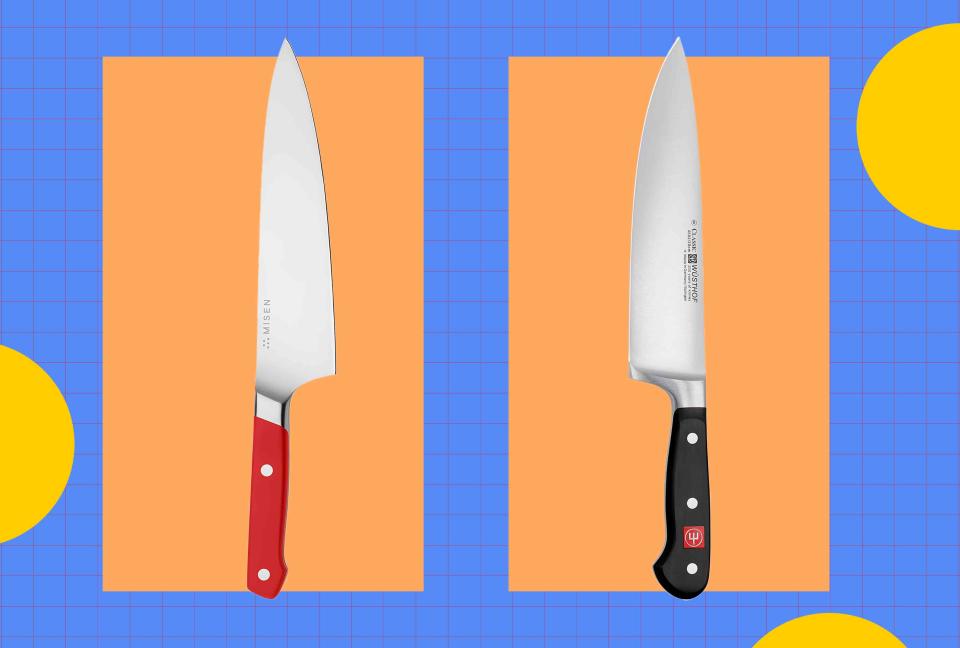
Courtesy of Brand
Ask any cook—professional or beginner—and they’ll tell you there is one tool in the kitchen that gets used more than anything else: A chef’s knife. Its versatility, from cutting through vegetables and meat to chopping herbs and nuts, is why it’s always listed on every list of kitchen must-haves. But with so many options out there, from small to large, light to heavy, inexpensive to really expensive, which do you choose?
In general, chef’s knives fall into two categories: Japanese-style and German-style. Japanese-style knives tend to be lighter in weight, and they're made of harder steel and have a straighter blade that's ideal for precision slicing. German-style knives tend to be heavier, made of softer steel and curved to facilitate that rocking back-and-forth motion that helps you cut through items like herbs and vegetables efficiently.
Since we all are different sizes, your favorite knife might be different from the one that a 6-foot-tall restaurant chef prefers. To that end, I've consulted with numerous EatingWell editors to compile a list of their favorite chef's knives that meet the needs of all levels of cooks and budgets. Some of our editors cook a little, and some cook a lot; some editors have small hands and prefer a lighter knife, while others prefer to wield the kitchen equivalent of a broadsword. Read on for our list of the best chef’s knives for all levels of cooks.
Our Chef's Knife Recommendations
Best Overall: MAC Professional 8-Inch Hollow Edge Chef’s Knife
Best Santoku: Cutco 7-Inch Santoku
Best for Beginners: Henckels Forged Premio 8-Inch Chef’s Knife
Best Value: Misen Ultimate 8-Inch Chef’s Knife
Best German-Style: Wüsthof Classic 8-Inch Chef’s Knife
Best Japanese-Style: Global 8-Inch Chef’s Knife
Best Splurge: Shun Premier Chef’s Knife 8-inch
Best Overall: MAC Professional 8-Inch Hollow Edge Chef’s Knife
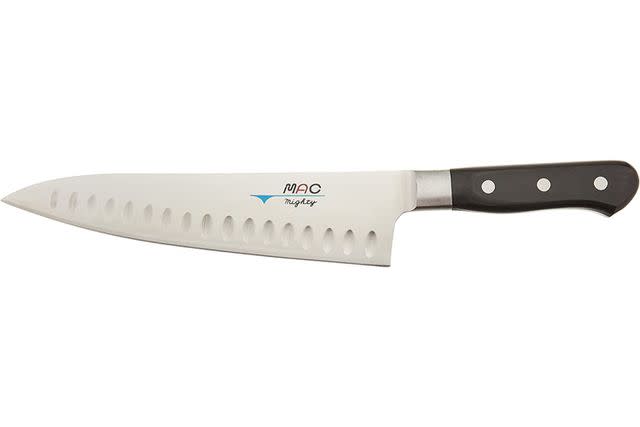
Amazon
What we like: Most balanced weight, has a razor-sharp edge.
What to know: Requires a bit of extra care when cleaning.
Whether you’re slicing a tomato for a sandwich or making a feast for 20, there is no better chef’s knife to accomplish it all than the MAC Professional. It’s lightweight, incredibly sharp and has a handle that feels comfortable even after hours of chopping and slicing. This is the knife that recipe testers grab time and time again because it can cut through delicate and dense vegetables as easily as it can break down a chicken.
The MAC combines the best features of both Japanese and German-style knives. It has a higher carbon content, like a Japanese knife, making it comfortable enough to wield for hours. At the same time, it also has a slightly rounded shape like a German-style knife, making it ideal for rocking through piles of fresh herbs. As the former test kitchen manager for EatingWell and the owner of 16(!) knives, I can guarantee you this is the chef’s knife for any level of cook, from professional to novice.
The only thing to remember is that because of its higher carbon content in the steel and the wood handle, this knife should be washed and dried fully before being put away. Any water left on the blade may cause discoloration.
Length: 8 inches | Blade Material: Stainless steel | Handle Material: Wood | Weight: 6.8 oz.
Best Santoku: Cutco 7-Inch High Carbon Santoku
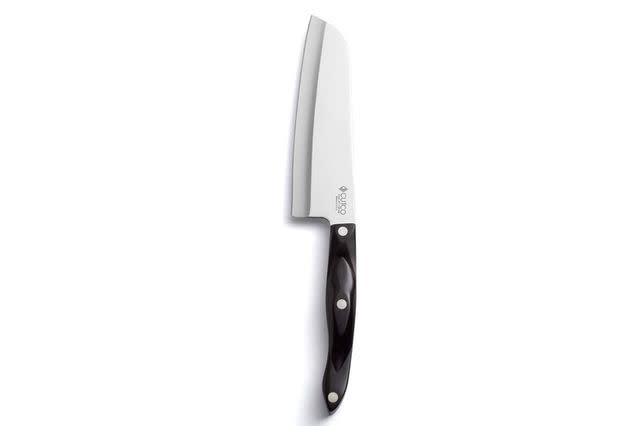
Amazon
What we like: It's very easy to clean, and it comes with a lifetime warranty.
What to know: Not the prettiest knife to look at.
Like a chef’s knife, a santoku knife is a general-purpose knife, and it excels at tasks such as slicing, dicing and chopping. However, a santoku knife is technically different from a chef’s knife. A santoku has a thinner blade and rounded top without a sharp tip, making it ideal for precise downward cuts.
Nutrition Editor and avid cook Jessica Ball is a huge fan of the santoku from Cutco knives. “I was gifted a set of Cutco knives, and their 7-inch santoku knife is my most-used and favorite. I love the weight of it (it's a little heavier than my other chef’s knives) and think it's the perfect size for chopping most things. Also, since it's stainless steel and has a glossy finish on the handle, it's super easy to clean. It's a bit of a splurge, but it makes a great gift, and they have a lifetime warranty.”
Length: 7.25 inches | Blade Material: Stainless steel | Handle Material: Plastic | Weight: 6.6 oz.
Best Value: Misen Ultimate 8-Inch Chef’s Knife
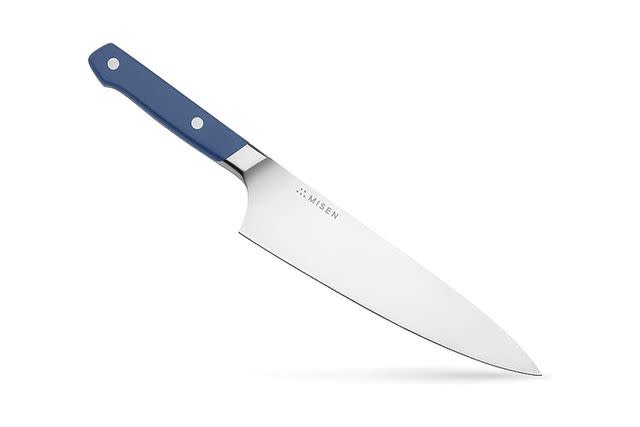
Amazon
What we like: Excellent knife that performs very well for the price.
What to know: It dulls quicker than other knives, so it needs to be sharpened more often.
If you want form and function without the hefty price tag of a German or Japanese knife, there is no better choice than the Misen 8-Inch Chef’s Knife. In fact, I buy these in bulk when they go on sale to give to any friend who is starting to dip their toes into serious cooking.
Carolyn Malcoun, our associate editorial director, agrees. “I love my Misen. It feels nice in my hand, looks pretty (mine has a blue handle) and sharpens easily and well.” The Misen knife used to only come in the blue color, but they’ve expanded to green, red, gray and black—though I agree with Carolyn: I love the classic blue.
Length: 8 inches | Blade Material: Stainless steel | Handle Material: Plastic | Weight: 8 oz.
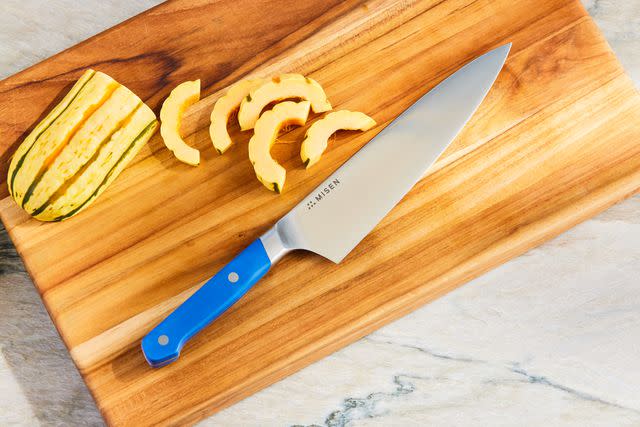
EatingWell / Russell Kilgore
Best German-Style: Wüsthof Classic 8-Inch Chef’s Knife
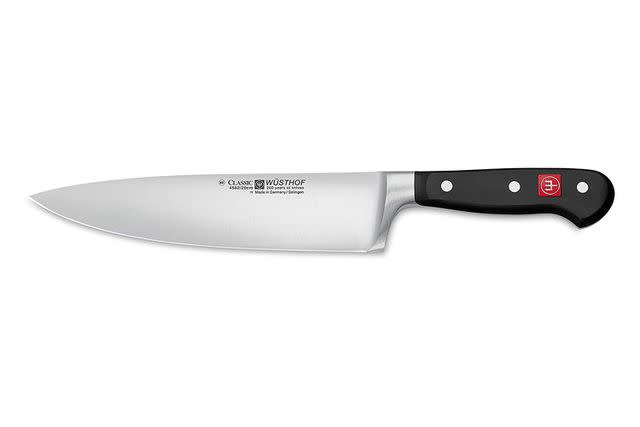
Amazon
What we like: Heavy-duty knife that can handle just about anything.
What to know: Might be intimidating for beginner cooks.
The Wüsthof 8-Inch Chef's Knife is the first knife you’ll pick up on the first day of culinary school at Le Cordon Bleu, says senior nutrition & news editor Maria Laura Haddad-Garcia. “The chef's knife I use is Wüsthof. I like it a lot, and I've been using it for more than 10 years.”
And rightfully so. The German-made knife is the favorite of many seasoned cooks and chefs because of its heavy weight and ability to easily be sharpened at home. The rounded edge, thick steel, and solid handle make this a knife you’ll have for a lifetime. But don’t just take Haddad-Garcia’s recommendation; the Wüsthof is also a favorite of Ina Garten's.
Length: 8 inches | Blade Material: Stainless steel | Handle Material: Plastic | Weight: 8.3 oz.
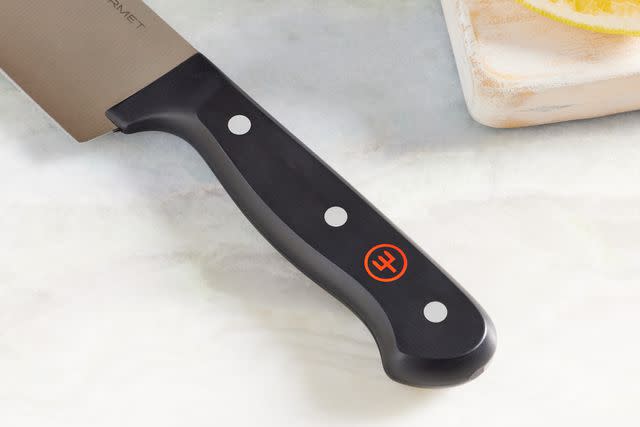
EatingWell / Nick Simpson
Best for Beginners: Henckels Forged Premio 8-Inch Chef’s Knife
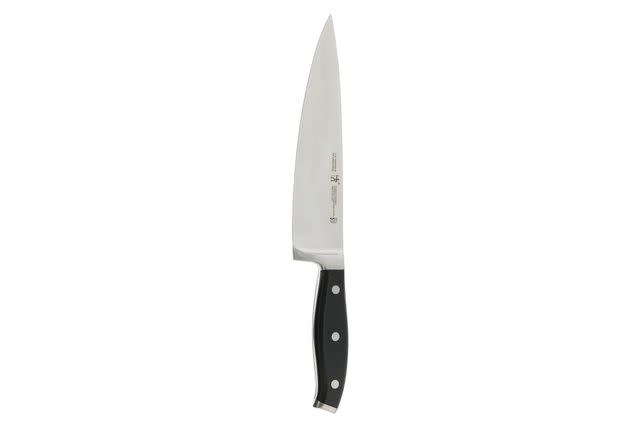
Amazon
What we like: Heavier German-style knife that can handle large vegetables, like butternut squash.
What to know: Blade is lower on the hardness scale than the others, so it needs to be sharpened more frequently.
When you are looking for an affordable chef’s knife for a beginner, look at the Henckels line from Zwilling. The Henckels knives, which often come in affordable sets, have the same design and general feel as their more expensive Zwilling counterparts, but they're made with less costly materials to help keep the price point low.
Associate food editor Alex Loh says, “I love the feel of this knife in my hand. It's comfortable to grip and is the perfect weight, especially compared to other ones I've tried that have felt too light. Even with a lower price point, the knife is of excellent quality. It's my go-to choice in my knife block."
Length: 8 inches | Blade Material: Stainless steel | Handle Material: Plastic | Weight: 8 oz.
Best Japanese-Style: Global 8-inch Chef’s Knife
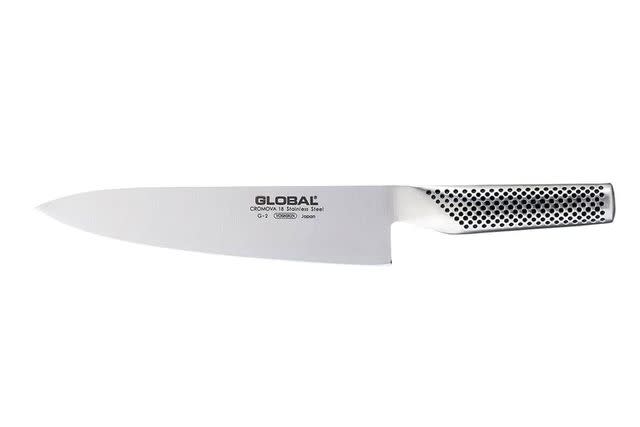
Amazon
What we like: Lightweight and easy to use, especially for those with smaller hands.
What to know: Takes a bit more effort to cut through dense foods like root vegetables.
As someone who is on the petite side and has small hands, the Japanese Global 8-Inch Chef’s Knife was the first knife that felt comfortable when I started cooking professionally at 19. At 5.75 ounces, this knife is considerably lighter than the German knives, which typically weigh about 8 ounces. While that might not seem like a lot of weight, it truly is noticeable when you are chopping pounds and pounds of potatoes, onions and carrots.
Another thing that sets this knife apart is its construction. While many knives (including all the others on this list) are made of a steel blade with a plastic or wooden handle, this Global knife is made from one single piece of steel.
Length: 8 inches | Blade Material: Stainless steel | Handle Material: Stainless steel | Weight: 5.75 oz
Best Splurge: Shun Premier Chef’s Knife 8-Inch
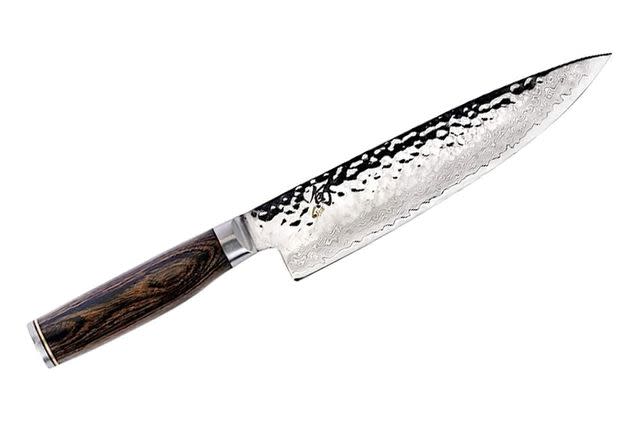
Amazon
What we like: As beautiful as it is functional and extremely sharp.
What to know: It’s best to get this knife professionally sharpened.
If you appreciate beauty as much as function, like assistant general manager Penelope Wall, then the Shun Premier is your knife. “My favorite is my Shun! I already had two very good chef's knives before I got my Shun, but I do a lot of chopping at home, and this is the one I always reach for," says Wall.
"It has a very sharp, precise blade, but my favorite thing about the Shun is its handle," she continues. "The handles on my other knives are two pieces of wood riveted to the side of the knife blade. Sometimes if I'm chopping a lot, my hand gets sore from where it rubs at the seam where the metal meets the wood. But the Shun handle is one smooth piece of wood. It feels so comfortable in my hand. It's also beautifully crafted, almost like a piece of art. This knife was actually gifted to me, but I've bought several Shun knives since because I love it so much.”
I, too, have this knife at home, and my favorite thing about it is that my husband thinks it’s too pretty to use (he opts for the Misen), so I never have to worry about anyone else touching my Shun!
Length: 8 inches | Blade Material: Stainless steel | Handle Material: Wood | Weight: 7.7 oz
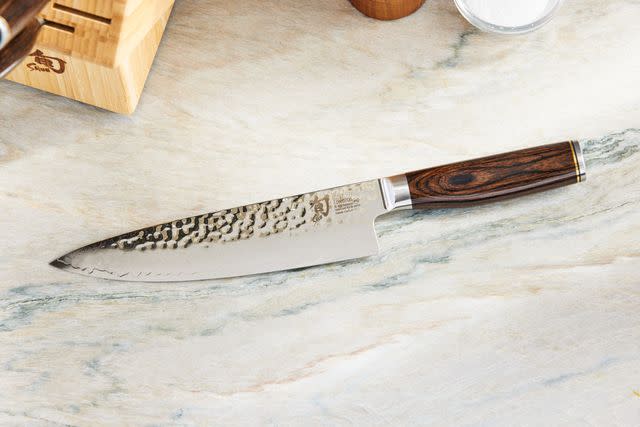
EatingWell / Russell Kilgore
The Bottom Line: The Best Chef’s Knives
While our overall favorite is the MAC Professional 8-inch Hollow Edge Chef’s Knife (view at Amazon), choosing a chef’s knife is a personal decision based on how much you cook and how much you want to spend. Professional cooks who use their knives daily for hours on end tend to pick stronger and more comfortable chef’s knives that can withstand heavy use and frequent sharpening. Novice cooks and those on a budget should look for well-made knives that fit their needs but don’t need professional sharpening. Since you can’t feel what a knife will be like from a computer screen, try testing out a few at a local cookware store. Holding the knife in your hand is the best way to determine if it will work well for you.
Choosing a Chef’s Knife
Your Chef's Knife Design
Chef’s knives tend to fall into one of two categories: Japanese-style and German-style. Japanese-style knives are typically made from high-carbon stainless steel and tend to be lighter and thinner. Meanwhile, German-style knife blades have less carbon and more iron content, so they tend to be heavier and thicker. The lighter Japanese knives are best for making finer, more precise cuts, while the German-style knives are more durable and can withstand heavier-duty chopping, like cutting through bones and joints.
Size and Length of the Chef's Knife
A standard chef’s knife is 8 inches long. This is the perfect length for most kitchen tasks, from cutting all sizes of vegetables to breaking down proteins, like chicken and beef. Chef’s knives can come in sizes ranging from 6 to 14 inches; however, we’ve found that 6 inches isn’t hefty enough to tackle larger produce like squash and melons, and anything over 10 inches can feel unwieldy.
Materials and Durability
The durability of a knife largely depends on the materials used for both the blade and handle, as well as how the knife is maintained in the kitchen. If the stainless steel is stronger, as indicated by the Rockwell hardness scale, and the handle is of better quality, then the knife will last longer. All knives require occasional sharpening, which can be done by a professional or at home. However, the quality of the steel ultimately determines how long a knife can last.
Determine Your Budget
With a chef’s knife, you can get extremely good quality without having to splurge. In fact, two of our editors’ favorites are under $100. The trick is to find a knife that fits your budget and you actually enjoy using.
Common Questions
What is a chef’s knife used for?
A chef’s knife is the MVP of most kitchens. Its broad, sharp blade is ideal for chopping, slicing and dicing a wide range of ingredients, from fruits and vegetables to meats and herbs. The weight and balance of a chef’s knife make it great for both precision work, such as julienning a cabbage for coleslaw, and tougher tasks like chopping a winter squash. It also provides a satisfying way to peel garlic, and if you don’t have a carving knife, a chef’s knife works just as well for carving a chicken or turkey.
How do you clean a chef’s knife?
If you want your chef’s knife to last you for decades, cleaning it properly is one of the most important things you can do. Start by rinsing the knife immediately after use with warm, soapy water, then use a soft sponge or cloth to remove any food residue. You’ll want to pay extra attention to the handle, especially if it’s made of wood, as its porosity can contribute to bacteria growth. Dry your knife promptly, and store it in a knife block or a magnetic knife holder to protect the blade. We never recommend placing a chef’s knife in the dishwasher because the high heat and chemicals can damage the blade and the handle.
What is the best way to sharpen a chef’s knife?
The best way to sharpen a knife is to take it to a professional who can create an almost-new edge on your knife. Professional and avid home cooks often get their knives sharpened at least twice a year. However, if you want to sharpen your knives at home, it’s best to learn how to use a sharpening stone. Using a sharpening stone takes some practice, but these are the basic steps:
Wet your stone, either with water or oil (depending on the type of stone you use), and place it on a stable surface.
Hold your chef’s knife at a 15- to 20-degree angle to the stone. It’s important to maintain a consistent angle throughout the process.
Using even strokes, draw the blade across the stone from base to tip. Repeat 10 to 20 times, then flip the knife over to repeat the process on the other side.
Which size of chef’s knife is best?
We prefer an 8-inch chef’s knife because it’s the perfect size for most of your chopping or slicing needs. However, if an 8-inch knife feels too large or heavy, a 6-inch chef’s knife can accomplish almost everything an 8-inch chef’s knife does. That said, if you are regularly cutting a lot of large vegetables or fruits with tough rinds, a 10-inch knife might be a better choice.
What are the different types of kitchen knives?
There are many types of kitchen knives. A chef’s knife is your general go-to knife as it can cut just about everything; however, there are other types of knives that are more specific to certain tasks. As we mentioned above, a santoku is also a general-purpose knife that’s great for cutting vegetables because of its wide, rounded blade. A serrated knife, i.e., a bread knife, is suitable for cutting more than just bread; we also like to use it to cut eggplant and tomatoes. A utility knife is smaller than a chef’s knife (usually around 6 inches) but larger than a paring knife, and is used for smaller jobs like slicing fruit. A paring knife is a small knife, usually about 3 inches long, that is used for more precise jobs, such as removing the rind from a lemon.
Our Trusted Expertise
Breana Lai Killeen, M.P.H, RD, is a Chinese and Jewish chef and dietitian with over 15 years of experience creating editorial and digital content for top food and kitchen brands. For 10 years, Breana was a food editor turned test kitchen and editorial operations manager for EatingWell magazine. Breana owns 16 chef’s knives and has chopped, diced, minced and edited over 2,500 recipes in home and professional kitchens.
This article was edited by Katie Tuttle, a commerce editor and contributor to publications such as Food & Wine and The Spruce Eats.
Read the original article on Eating Well.

